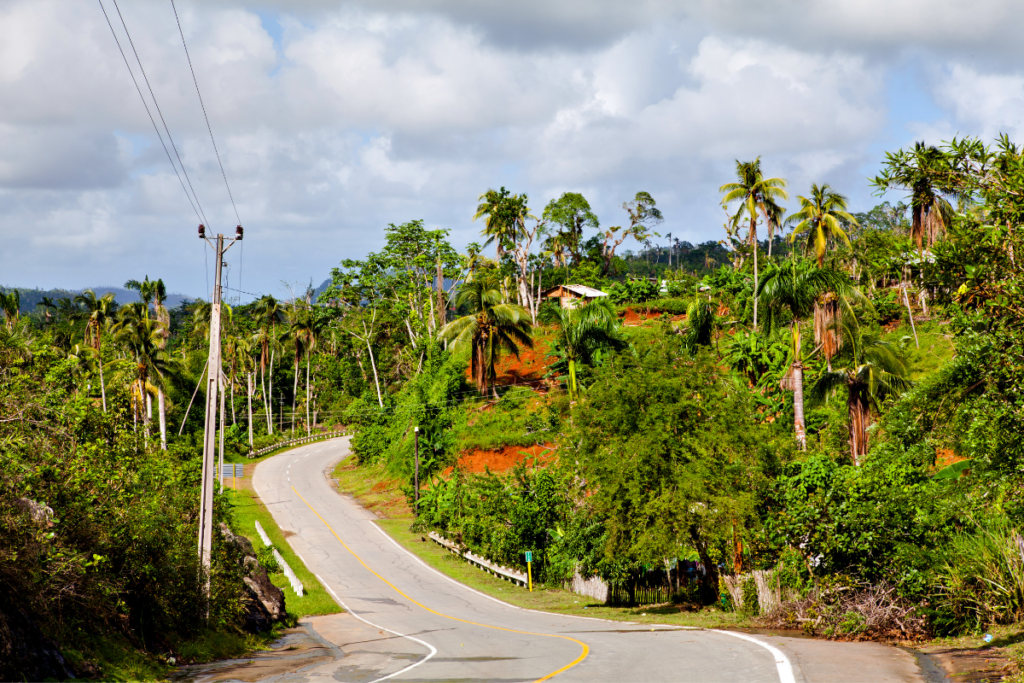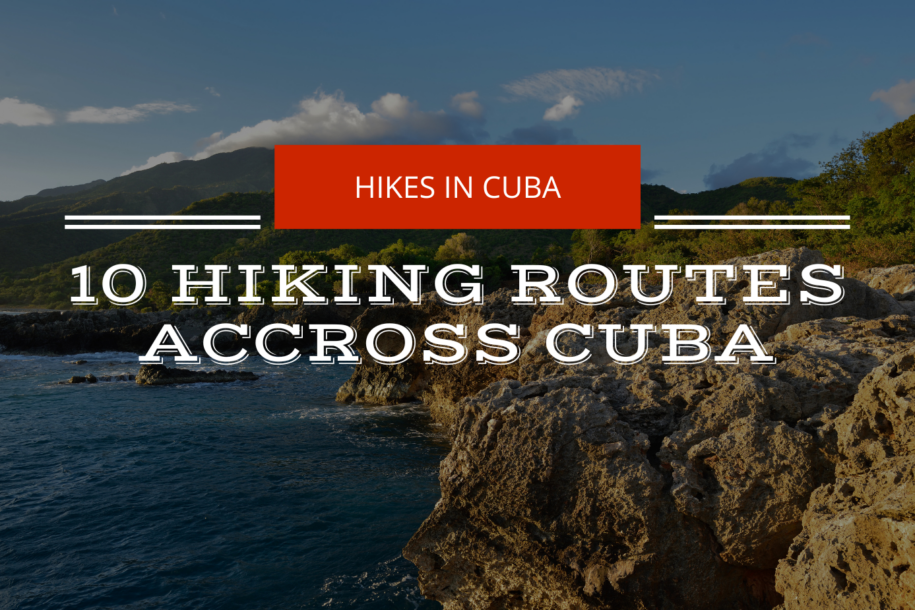When most people think of Cuba, they picture vibrant streets filled with classic cars, rum cocktails, and salsa music. While those elements are a major part of the Cuban experience, the island also boasts incredible natural beauty.
For adventurous travelers, hikes in Cuba offer an intimate glimpse into the country’s diverse landscapes—from lush forests and misty mountains to coastal cliffs and hidden waterfalls. Here’s a guide to 10 scenic hiking routes across Cuba that should be on your travel bucket list.
Table of Contents

1. El Yunque, Baracoa
Rising dramatically behind the coastal town of Baracoa in eastern Cuba, El Yunque is one of the most iconic mountains in the country. This flat-topped peak, which stands 575 meters above sea level, is part of a UNESCO biosphere reserve. The hike to the summit offers breathtaking views of the coastline and surrounding forests. Along the way, you’ll cross rivers and encounter Cuba’s unique flora and fauna, including the colorful Cuban trogon, the national bird. For nature lovers, this is one of the best hikes in Cuba.
2. Pico Turquino, Sierra Maestra
At 1,974 meters, Pico Turquino is the highest point in Cuba. Located within the Sierra Maestra mountain range, this challenging hike is not for the faint of heart. The trail starts in the village of Alto del Naranjo and takes about two days to complete. As you ascend, you’ll walk through cloud forests, pass coffee plantations, and follow in the footsteps of Cuban revolutionaries, who used these mountains as their base during the 1950s. The reward for your efforts? Unparalleled views over the southeastern coastline.
3. Sendero Enigma de las Rocas, Zapata Peninsula
Located in the Zapata Peninsula, which is home to one of the largest wetlands in the Caribbean, this hike is a unique way to experience Cuba’s lesser-known ecosystems. The trail meanders through mangroves, forests, and limestone caves, offering opportunities to spot rare bird species like the Cuban pygmy owl and the bee hummingbird, the smallest bird in the world. The hike ends at a natural swimming hole surrounded by lush greenery—a perfect spot to cool off after exploring one of the most intriguing hikes in Cuba.
4. Salto del Guayabo, Pinares de Mayarí
Nestled in the mountainous region of Pinares de Mayarí, the Salto del Guayabo waterfall is the highest in Cuba, with a drop of 85 meters. The hike to reach it is moderately difficult and takes you through pine forests and rolling hills. Along the trail, you’ll be treated to panoramic views of the surrounding valleys and rivers. This off-the-beaten-path experience is ideal for those looking to enjoy the tranquility of nature while exploring the hidden gems of Cuba.
5. Cueva de los Portales, Viñales
While Viñales is famous for its tobacco fields and mogotes (karst mountains), it also offers excellent hiking opportunities. The Cueva de los Portales trail is a must for history buffs, as this cave was once Che Guevara’s headquarters during the Cuban Missile Crisis. The hike takes you through verdant fields and valleys, with opportunities to explore the cave itself and learn about its historical significance. Viñales is already a highlight for visitors, and this trail adds a deeper connection to both nature and history.
6. Topes de Collantes, Escambray Mountains
Located near Trinidad, the Topes de Collantes National Park is a paradise for hikers. The park offers several trails, but the most popular is the hike to Salto del Caburní, a stunning waterfall that cascades down into natural swimming pools. This moderate hike takes you through thick forests, where you’ll see a variety of wildlife, including the Cuban parrot and tree frogs. After the hike, a dip in the cool waters beneath the falls is the perfect reward. If you’re looking for scenic hikes in Cuba, Topes de Collantes should be on your list.
7. Gran Piedra, Santiago de Cuba
Gran Piedra, or “Big Rock,” is exactly what its name suggests—a massive boulder perched atop a mountain at 1,225 meters above sea level. The hike to the summit is relatively short but steep, taking you up a series of stone steps to the top. Once there, you’ll be rewarded with sweeping views of the surrounding mountains and the Caribbean Sea. On a clear day, you can even see Jamaica in the distance. The cool mountain air makes this one of the more comfortable hikes in Cuba, even in the summer months.
8. Guanayara Trail, Trinidad
For those looking to combine a bit of history with nature, the Guanayara Trail in the Escambray Mountains is a perfect choice. Starting near the colonial town of Trinidad, this trail winds through forests and leads to El Rocío waterfall, where you can take a refreshing swim. Along the way, you’ll pass through coffee plantations and learn about the area’s role in Cuba’s revolutionary history. The trail is moderately challenging, but the chance to experience both natural beauty and cultural heritage makes it one of the more rewarding hikes in Cuba.
9. Sendero Maravillas de Viñales, Viñales Valley
Another gem in the Viñales region, the Maravillas de Viñales trail takes hikers through the heart of the valley, where you’ll pass by towering mogotes, tobacco fields, and rural Cuban homes. This hike is relatively easy and accessible to most fitness levels, making it perfect for families or those looking for a leisurely experience. The combination of stunning landscapes and rich agricultural traditions makes this one of the most scenic hikes in Cuba.
10. Loma de la Cruz, Holguín
For a quick yet rewarding hike, Loma de la Cruz in Holguín offers stunning panoramic views of the city and its surroundings. The hike involves climbing 458 steps to reach the top, where a large cross stands. Local legend has it that the cross protects the city from disasters. The view from the summit is particularly beautiful at sunset, when the city below is bathed in a golden glow. It’s a short but memorable hike that gives you a new perspective on Holguín and its nearby mountains.
Frequently asked questions
What is the best time of year to go hiking in Cuba?
The best time for hiking in Cuba is during the dry season, which runs from November to April. During this period, temperatures are more comfortable, and there’s less rainfall, making the trails safer and more enjoyable. The wet season (May to October) can bring heavy rains, especially in mountainous regions, which may lead to slippery conditions and potential trail closures.
Are guided hikes available in Cuba, or can I hike independently?
Yes, guided hikes are widely available in Cuba, especially in national parks and protected areas like Viñales, Topes de Collantes, and Pico Turquino. Local guides are knowledgeable about the terrain, history, and wildlife, enhancing the experience. Independent hiking is possible in many areas, but it’s recommended to use a guide for more remote or challenging routes, as trail signage can be limited, and some areas may have restricted access.
What should I bring for a hike in Cuba?
For hiking in Cuba, pack light but essential gear. Bring sturdy, comfortable hiking shoes, sun protection (hat, sunscreen, sunglasses), insect repellent, plenty of water, and snacks. A lightweight rain jacket is also useful, especially if you’re hiking during the wet season. If you’re hiking in remote areas, consider packing a small first-aid kit and a map or GPS device, as cell service can be spotty in some regions.
Final Thoughts
Whether you’re an experienced hiker or a casual adventurer, hikes in Cuba offer a diverse range of experiences. From challenging mountain treks to leisurely valley walks, these 10 scenic hiking routes will give you a deeper appreciation of the island’s natural beauty and rich history.
As you explore the trails, you’ll discover a side of Cuba that few tourists get to see—one that’s filled with quiet forests, hidden waterfalls, and breathtaking vistas. So lace up your hiking boots and hit the trails—you won’t regret it!
